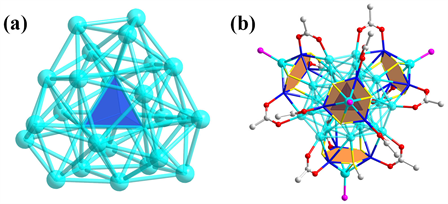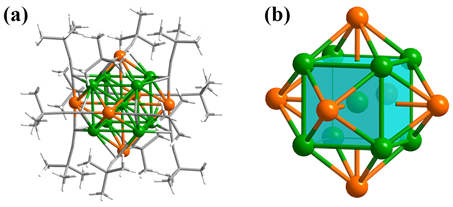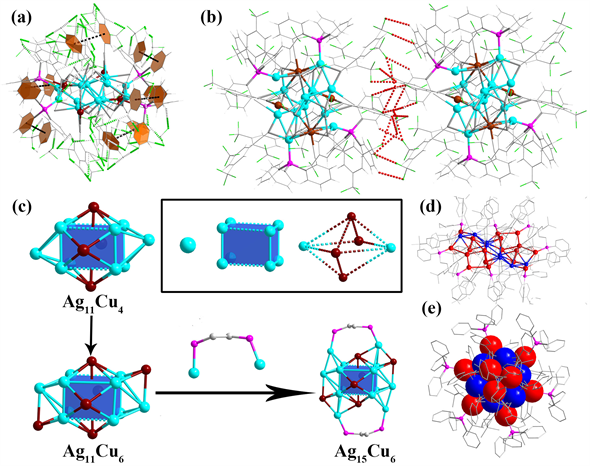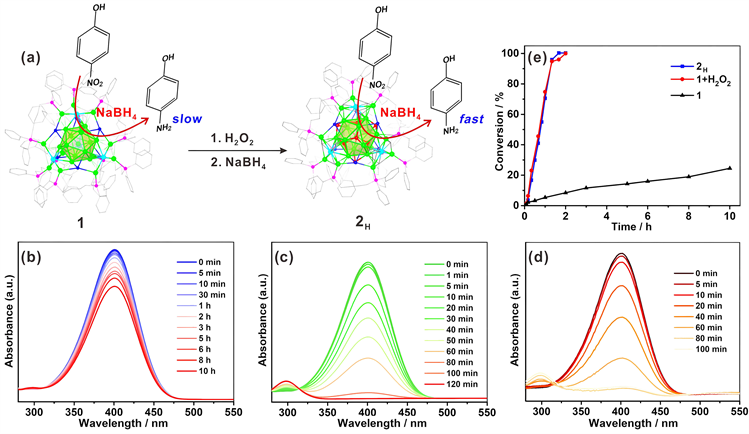Material Sciences
Vol.
13
No.
05
(
2023
), Article ID:
66109
,
12
pages
10.12677/MS.2023.135047
Ag-Cu双金属纳米团簇的研究进展
袁江陆,田凡*
武汉工程大学化学与环境工程学院,绿色化工过程教育部重点省重点实验室,新型反应器与绿色化学工艺湖北省重点实验室,湖北 武汉
收稿日期:2023年4月16日;录用日期:2023年5月20日;发布日期:2023年5月29日

摘要
金属纳米团簇作为连接金属有机配合物与金属纳米颗粒之间的桥梁,由于在原子级别上精确的结构与独特的理化性质,在近几十年中受到了越来越多研究者的关注。杂原子掺杂制备合金纳米团簇不仅是扩展团簇结构组成的有效方法,同时也是实现团簇功能化的一种有效策略。本文主要介绍了Ag-Cu双金属纳米团簇的合成以及在催化应用中的研究进展,最后对Ag-Cu双金属纳米团簇的研究中所存在的问题进行了总结,对未来的发展进行了展望。
关键词
Ag-Cu,双金属,纳米团簇

Research Progress of Ag-Cu Bimetallic Nanocluster
Jianglu Yuan, Fan Tian*
Hubei Key Laboratory of Novel Reactors and Green Chemical Processes, Key Laboratory of Green Chemical Processes of Ministry of Education, School of Chemical and Environmental Engineering, Wuhan Institute of Technology, Wuhan Hubei
Received: Apr. 16th, 2023; accepted: May 20th, 2023; published: May 29th, 2023

ABSTRACT
Metal nanocluster, as a bridge connecting organometallic complex and nanoparticles, has attracted more and more attention in recent decades because of its precise structure and unique physical and chemical properties. Alloying is not only an effective method to extend the structure of nanoclusters, but also an effective strategy to achieve cluster functionalization. This review mainly introduces the research progress of the synthesis and the catalytic application of Ag-Cu bimetallic nanoclusters. Finally, the existing problems in the study of Ag-Cu bimetallic nanoclusters are summarized, and the future development has prospected.
Keywords:Ag-Cu, Bimetallic, Nanocluster

Copyright © 2023 by author(s) and Hans Publishers Inc.
This work is licensed under the Creative Commons Attribution International License (CC BY 4.0).
http://creativecommons.org/licenses/by/4.0/


1. 引言
金属纳米团簇是一种具有精确的几何结构和原子组成的新型纳米材料 [1] [2] ,其尺寸介于金属有机配合物与金属纳米颗粒之间,被认为是连接分子与纳米颗粒之间的桥梁。因此,金属纳米团簇具有许多类似分子的理化性质。比如,由于量子尺寸效应,金属纳米团簇不再具有纳米颗粒的表面等离子共振效应,而因具有离散的电子能级而表现出分子的特性 [3] 。同时,由于具有精确的原子组成与独特的电子结构,金属纳米团簇在催化、化学传感、发光、生物标记等诸多领域具有广阔的应用前景 [4] [5] [6] [7] 。近年来,Ag基纳米团簇由于其独特的光学性质与生物学应用前景备受关注。在过去的十几年里,大量的Ag基纳米团簇新结构如Ag23 [8] 、Ag25 [9] 、Ag29 [10] 、Ag33 [11] 、Ag44 [12] [13] [14] 等先后被合成报道出来,在丰富团簇结构的同时,也为Ag基纳米团簇的结构开发和应用奠定了基础。然而,当前Ag基团簇的研究中仍存在稳定性相对较差与表面金属原子暴露少的问题,在相关的应用上存在很大的局限。
引入异质金属原子制备合金纳米团簇是不仅是调控金属纳米团簇的理化性质的有效策略,也是一种扩展团簇分子结构有效方法 [15] 。Cu原子与Ag原子位于元素周期表中的同一副族,二者具有相似的电子排布规律,因此Cu原子可以作为一种理想的异质金属原子。研究发现,在Ag基纳米团簇结构中引入Cu元素,能够实现团簇结构稳定的同时还有利于表面金属原子的暴露。
2. Ag-Cu双金属纳米团簇合成的研究进展
配体保护的Ag-Cu双金属纳米团簇主要通过金属原子交换法与共还原法合成,在当前文献报道的Ag-Cu双金属纳米团簇中,常用的配体主要包括巯基配体、炔基配体和膦配体。此外,也有部分的Ag-Cu双金属纳米团簇中使用卤素离子和硫离子等无机离子作为配位基团。
2.1. 巯基配体保护的Ag-Cu双金属纳米团簇
2.1.1. 单一巯基配体保护的Ag-Cu双金属纳米团簇
2016年,厦门大学郑南峰课题组以2,4-二氯苯硫酚为配体,在Ag、Cu两种金属前驱体共存的条件下,首次通过共还原法得到了具有手性的[Ag28Cu12(SR)24]4-双金属纳米团簇(图1(a)),该团簇的内核为4个Ag原子组成的Ag4四面体,四面体的每个面均被外围的6个Ag原子组成的Ag6平面覆盖,形成Ag4@Ag24的核心(图1(b)),并由外层的4个Cu3(SR)6单元保护。其中Cu3(SR)6中的3个Cu原子与6个S原子几乎处在同一平面,并且硫醇配体之间存在三对π…π相互作用(图1(c)),导致团簇中的Cu原子得到了部分地暴露 [16] 。2020年,Anumula等人也采用一锅法合成了由6个2,4-二甲苯硫酚配体保护的Ag3Cu2双金属纳米团簇,该金属纳米团簇也是迄今为止所报道的最小的Ag-Cu双金属纳米团簇。其X-射线单晶衍射结果表明(图1(d)),该Ag3Cu2纳米团簇的两个Cu原子位于Ag3三角形平面的两侧,形成一个三角双锥的金属内核,6个硫醇配体充分保护了三角双锥的6个Cu-Ag键,增强了该团簇的稳定性 [17] 。在2022年,Xia等人在以环己硫醇为配体的条件下也得到了目前最大的Ag-Cu双金属纳米团簇Ag77Cu22(CHT)48 [18] 。
以上的单一巯基配体保护的Ag-Cu双金属纳米团簇均是在Ag,Cu两种金属前驱体与一种硫醇配体存在的条件下,通过共还原法合成得到。然而,部分的单一巯基配体保护的Ag-Cu双金属纳米团簇的合成却十分依赖于膦配体的参与。例如,Bao等人在金刚烷硫醇与双二苯膦基甲烷两种有机配体共存的条件下,得到的一种全新的Ag13Cu10合金纳米团簇,其结构如图1(e)所示,该团簇由一个Ag13二十面体的内核与Cu10(SAdm)12壳层组成。而有趣的是,该双金属纳米团簇仅由12个金刚烷硫醇保护,反应体系中的膦配体却不在晶体结构中,并且该Ag-Cu双金属纳米团簇的合成必须依赖于膦配体的存在 [19] 。

Figure 1. The structure of Ag28Cu12 (a), Ag4@Ag24 core (b) and Cu3(SR)6 (c) of Ag28Cu12 [16] , the crystal structure of Ag3Cu2 (d) [17] and Ag13Cu10 (e) [19]
图1. Ag28Cu12团簇的晶体结构图(a),以及Ag28Cu12团簇的Ag4@Ag24核(b),与Cu3(SR)6示意图(c) [16] ,Ag3Cu2 (d) [17] 和Ag13Cu10 (e) [19] 的晶体结构图
2.1.2. 巯基与膦配体共配的Ag-Cu双金属纳米团簇
巯基配体与膦配体的组合为金属纳米团簇提供了更多的配位环境,被广泛用于纯Ag纳米团簇结构的开发,目前已经有Ag14 [20] 、Ag18 [21] 、Ag23 [8] 、Ag29 [10] 、Ag33 [11] 、Ag50 [22] 等大量的硫醇配体与膦配体共同保护的Ag纳米团簇逐渐被报道出来。但是,目前报道的巯基与膦配体共配的Ag-Cu双金属纳米团簇的数量却非常有限。迄今为止,只有Li等人以3-甲基苯硫酚与三苯基膦为配体,在Ag、Cu两种金属前驱体共存的条件下,通过共还原法得到的3-甲基苯硫酚与三苯基膦共配的Ag30Cu14(SR)28(PPh3)4双金属纳米团簇 [23] ,以及Ma等人基于Ag39纳米团簇合成的[Ag37Cu2(PFBT)24(TPP)8]2- [24] 和Kang等人基于Ag29纳米团簇合成的Ag17Cu12(BDT)12(PPh3)4 [25] 等少数几个Ag-Cu双金属纳米团簇。
2.1.3. 巯基与无机离子共配的Ag-Cu双金属纳米团簇
在金属纳米团簇的合成过程中,金属前驱体等试剂的引入会导致无机离子存在于反应体系中。虽然卤素离子等无机离子通常会以反离子的形式存在,但是在合适的条件下,无机离子也会与金属原子产生配位 [26] ,对金属纳米团簇的合成、形态、结构和性质等方面产生关键作用。因此,在金属纳米团簇的合成中,无机离子的存在需要被充分考虑并控制。
2018年,安徽大学朱满洲教授课题组在反应体系中有氧气存在的条件下,得到了Ag40.13Cu13.87S19(tBuS)20(tBuSO3)12团簇(图2(a))。该团簇中除了叔丁基硫醇作为配体以外,还存在硫离子与对叔丁基磺酸基两种无机离子,其中硫离子由合成体系中的叔丁硫醇或谷氨胱肽转化而来,而对叔丁基磺酸基则由叔丁硫醇被氧气氧化而产生。与其他金属纳米团簇不同的是,该Ag-Cu双金属纳米团簇的核心除了含有10个Cu原子与两个Ag原子以外,还与7个S原子共同组成Cu10Ag2S7核心(图2(b)),团簇的壳层为42个金属原子组成的M42(tBuS)20(tBuSO3)12层(图2(c)),叔丁硫醇与叔丁基磺酸基以配体的形式存在于团簇分子的表面,磺酸基的3个氧原子分别与壳层中的3个Ag原子配位。团簇的核心与壳层通过另外的12个S原子相连(图2(d)) [27] 。此外,该课题组将反应体系中的硫醇换为金刚烷硫醇后,得到了硫离子参与配位的Cu30Ag61(SAdm)38S3团簇(图2(e)),而与Ag40.13Cu13.87S19(tBuS)20(tBuSO3)12团簇不同的是,Cu30Ag61(SAdm)38S3团簇的核心为13个Ag原子组成的正二十面体、壳层为Ag48(SAdm)38S3,核心与外壳由30个Cu原子组成的中间层相连。团簇中的硫离子既不参与核心的组成也不连接核心与壳层,而是位于壳层的表面 [28] 。另外,该课题组在膦配体辅助的条件下得到了醋酸根离子参与配位的Ag15Cu12(S-c-C6H11)18(CH3COO)3双金属纳米团簇(图2(f)) [29] ,这些研究为无机离子参与配位的Ag-Cu双金属纳米团簇的合成提供了有价值的参考。

Figure 2. The crystal structure of Ag40.13Cu13.87 (a) and the scheme diagram of core-shell structure of Ag40.13Cu13.87 (b)~(d) [27] , the crystal of Cu30Ag61 (e) [28] and Ag15Cu12 (f) [29]
图2. Ag28Cu12 (a) 晶体结构及其核壳结构示意图(b)~(d) [27] 与Cu30Ag61 (e) [28] 和Ag15Cu12 (f) [29] 单晶结构图
2.1.4. 巯基、膦配体以及无机离子共配的Ag-Cu双金属纳米团簇
三种不同类型的配体之间的相互组合虽然可以为Ag-Cu纳米团簇提供更加丰富的配位环境,但目前报道的同时含有这三种类型配体的Ag-Cu团簇的结构数量十分有限。目前只有Chai等人以对甲苯磺酸银与醋酸铜为金属前驱体,在金刚烷硫醇与三苯基膦两种配体共存的条件下,通过共还原法得到的Ag32Cu12(CH3COO)12(SAdm)12(PPh3)4纳米团簇。该双金属纳米团簇虽然由44个金属原子组成,但是其原子之间的排列方式与Ag44团簇并不一致,并非Ag44团簇的衍生结构,反而与Ag28Cu12团簇的结构十分相似,其核心结构为28个Ag原子组成的Ag4@Ag24核(图3(a)),壳层为4个Cu3(SR)3平面与12个醋酸根离子组成的Cu12(SR)12(CH3COO)12层。但是与Ag28Cu12团簇不同的是,该双金属团簇的Cu3(SR)3平面的3个S原子均与一个额外的Ag原子配位,并且该Ag原子以四配位的形式再与一个膦配体配位。另外,Ag32Cu12虽比Ag28Cu12少了12个金刚烷硫醇配体,但是表面的12个醋酸根离子与Ag28Cu12中的12个金刚烷硫醇的配位环境一致(图3(b)) [30] 。

Figure 3. The Ag28 core (a) and crystal structure of Ag32Cu12 nanocluster (b) [30]
图3. Ag32Cu12团簇的核心结构(a)与单晶结构(b)示意图 [30]
2.2. 炔基配体保护的Ag-Cu双金属纳米团簇
2.2.1. 全炔基保护的Ag-Cu双金属纳米团簇
除了巯基配体被广泛用于金属纳米团簇的合成,炔基配体在近年以来也逐渐被用于保护Ag-Cu双金属纳米团簇。例如,2013年,Connell等人将Ag14(C≡CtBu)12Cl团簇溶于四氢呋喃中,并在溶液中引入额外的[Cu(MeCN)4]BF4,通过金属原子交换法将Ag14团簇表面的6个Ag原子替换为Cu原子,得到了Ag8Cu6双金属纳米团簇 [31] 。2021年,Ma等人以高达40%的收率得到了结构与Ag8Cu6十分相似的全炔基保护的Ag9Cu6双金属纳米团簇。其单晶X-射线衍射结果(图4)表明该Ag9Cu6团簇具有Ag1@Ag8@Cu6的体心立方的结构,其中8个Ag原子组成了一个立方体,一个Ag原子占据Ag8六面体的中心位置,而6个Cu原子则分别覆盖Ag8立方体的6个面。进一步通过反“伽伐尼”还原法得到了中心Ag原子以及6个Cu原子被Au原子替换的Au7Ag8合金纳米团簇,相较于Ag9Cu6,其吸收光谱发生了明显的蓝移,其DFT计算表明,两种纳米团簇的不同吸收特征可归因于M1核(Ag vs Au)、M6八面体(Cu vs Au)的差异,以及Ag8立方体的细微几何差异 [32] 。同年,Ma等人得到了该Ag9Cu6双金属纳米团簇的纯Ag母体团簇Ag15 [33] ,这为探究金属纳米团簇的构效关系提供了一个新的模型。

Figure 4. The crystal structure of Ag9Cu6 (a) and the core of Ag9Cu6 (b) [32]
图4. Ag9Cu6单晶结构(a)及核心结构图(b) [32]
2.2.2. 炔基与膦配体共配的Ag-Cu双金属纳米团簇
炔基配体与膦配体共配也是合成Ag-Cu双金属纳米团簇是一种重要方法。例如,Deng等人报道了采用炔基配体与三苯基膦共同保护的Ag12Cu4(C≡CR)14(PPh3)4纳米团簇的合成,其单晶X-射线衍射结果表明该团簇由一个Ag6八面体内核与两个Ag3Cu2(C≡CR)7(PPh3)2单元组成,由于团簇分子内部以及团簇分子之间存在大量的C-H…F、C-H…π和π…π等非共价相互作用(图5(a),图5(b)),限制了纳米团簇分子的旋转和振动,团簇表现出明显的聚集诱导发光效应 [34] 。随后,Deng又得到了Ag15Cu6(C≡CR)18(DPPE)2团簇,该团簇虽然由21个金属原子组成,但是其分解结构(图5(c))表明,Ag15Cu6的核心结构仍然与Ag9Cu6的核心原子的排列方式相似 [35] 。此外,具有其他核心结构的[Ag18Cu8(DPPP)4(tBu-C6H4C≡C)22]4+ (图5(d)) [36] 、Ag13-xCu6+x(tBuC6H4C≡C)14(PPh3)6 (图5(e)) [37] 等其他炔基配体与膦配体共配的Ag-Cu双金属纳米团簇也逐渐被报道出来。

Figure 5. Intramolecular (a) and intermolecular (b) noncovalent interactions among the surface ligands of the Ag12Cu4 cluster [34] , schematic diagram of Ag15Cu6 decomposition structure (c) [35] and the structure of Ag18Cu8 (d) [36] and Ag13-xCu6+x (e) [37]
图5. Ag12Cu4团簇分子内与团簇分子间的C-H…F、C-H…π和π…π相互作用(a),(b) [34] ,Ag15Cu6分解结构示意图(c) [35] ,Ag18Cu8 (d) [36] 与Ag13-xCu6+x (e) [37] 单晶结构图
2.2.3. 炔基配体、膦配体与无机离子共配的Ag-Cu双金属纳米团簇
在炔基配体保护的Ag-Cu双金属纳米团簇中,无机离子与有机保护基的协同作用促进了团簇分子的形成和稳定。因此,对于这类金属纳米团簇的合成,也需要充分考虑和控制卤素离子的存在和作用。但是相比较于巯基保护的Ag-Cu双金属纳米团簇,炔基配体保护的Ag-Cu双金属纳米团簇结构中的无机离子的种类则单调许多,大多为卤素离子,并且这些卤素离子通常在团簇分子的表面与团簇的金属原子配位。例如,Deng等人在有PPh4Cl存在的合成体系下得到了氯离子参与配位的[Ag22Cu7(C≡CR)16(PPh3)5Cl6]-手性团簇,其中氯离子以三配位的形式与团簇分子表面的金属原子配位 [38] 。另外,由于合成体系中存在NaBH4等强还原剂的存在,部分的Ag-Cu双金属纳米团簇中存在氢负离子与金属原子配位。例如,Kaiyu Mikami等人合成的[Ag25Cu4H8Br6(C≡CPh)12(PPh3)12 [39] 和Yuan等人合成的Ag25Cu4Cl6(DPPB)6(PhC≡C)12 [40] 两个团簇中的不仅有6个卤素离子以四配位的形式在团簇分子的表面与4个Ag原子配位,还有额外的8个氢负离子与团簇的Ag13二十面体的内核配位。
综上所述,不同种类配体之间的相互组合不仅为Ag-Cu双金属纳米团簇提供了丰富的配位环境,也为Ag-Cu双金属纳米团簇的结构扩展提供了借鉴。本文中提到的配体保护的Ag-Cu双金属纳米团簇的配体组成如表1所示。
Table 1. Comparison of composing of ligands of Ag-Cu bimetallic nanoclusters
表1. Ag-Cu双金属纳米团簇的配体组成比较
3. Ag-Cu双金属纳米团簇的催化应用
3.1. 催化硼氢化钠还原4-硝基苯酚
4-氨基苯酚在制药工业中作为一种必不可少的中间体,也广泛用于照相显影剂、缓蚀剂、防腐润滑剂和染发剂,其常用的制备方法为通过催化NaBH4还原4-硝基苯酚 [41] [42] [43] [44] ,其催化剂选择多以金属基的纳米材料为主,而金属纳米团簇由于具有比金属纳米颗粒更小的尺寸与更大的比表面积 [15] ,同时,金属纳米团簇具有在原子级别上精确的结构;并且金属纳米团簇的结构在原子级别上可以精确地调控;金属纳米团簇的性质对其结构十分敏感的特点,金属纳米团簇逐渐被应用与催化NaBH4还原4-硝基苯酚反应中 [45] [46] [47] 。
Gao等人将Ag13-xCux与Ag9Cu6两个双金属纳米团簇用于催化4-硝基苯酚还原,结果表明两个Ag-Cu双金属纳米团簇具有较好的催化活性 [37] 。另外,Yuan等人成功合成并表征了两个结构相同的Ag-Cu双金属纳米团簇:Ag25Cu4Cl6(DPPB)6(PhC≡C)12(1)团簇和Ag25Cu4Cl6H8(DPPB)6(PhC≡C)12(2H)。这两个纳米团簇都有一个Ag13二十面体核心与相同的外围组成和结构,但(2H)有额外的8个氢负离子与Ag13内核中的Ag原子配位(图6(a))。其催化还原4-硝基苯酚实验结果(图6(b)~(e))表明,团簇(2H)在2小时内的转化率可以达到100%,而团簇(1)在相同条件下转化率只有8%,而(1)经H2O2氧化后可以转化为(2H),并且其催化活性能够提升至(2H)的水平。该工作不仅通过调控Ag25Cu4的核心结构的空间原子排布成功提升了Ag-Cu双金属纳米团簇催化4-硝基苯酚的还原性能,同时也证明了催化4-硝基苯酚还原过程中,氢负离子为催化反应中的活性物种 [40] 。

Figure 6. Schematic diagram of the conversion from 1 to 2H (a), UV-vis spectra showing gradual reduction of 4-nitrophenol catalyzed by different catalysts: 1 (b), 2H (c), and 1 (d) in the presence of H2O2. Conversion over 1, 2H, and 1 in the presence of H2O2 (e) [40]
图6. 团簇1转化为团簇2H示意图(a),团簇1与团簇2H以及团簇1在H2O2存在的条件下催化4-硝基苯酚还原溶液的吸收光谱图(b)~(d),团簇1与团簇2H以及团簇1在H2O2存在的条件下催化4-硝基苯酚还原转化率(e) [40]
3.2. 电催化CO2还原
金荣超教授课题组在发现Au25纳米团簇具有电催化CO2还原的活性之后,通过调控Au25纳米团簇的结构并结合理论计算,系统地研究了团簇的电荷 [48] 、形貌 [49] 、金属原子组成 [50] 以及硫醇配体的种类 [51] 对Au25纳米团簇催化CO2还原性能的影响,并提出了纳米团簇在电催化CO2还原过程中的配体解离而暴露活性位点的催化机制。之后,越来越多的金属纳米团簇逐渐被用于电催化CO2还原反应,并通过调控金属纳米团簇的结构改善团簇催化性能并探究团簇的精细结构对催化CO2还原性能的影响 [33] [52] [53] 。但是,目前文献报道的金属纳米团簇催化CO2还原的产物多为CO。由于Cu基催化剂可以抑制电催化CO2还原过程中的析氢副反应的发生,并且具有较高的多碳产物的选择性 [54] [55] [56] ,而由于Cu纳米团簇的稳定性较差 [57] ,研究人员通常合成含Cu的合金纳米团簇用于电催化CO2还原反应。
研究表明,Ag15Cu6不仅可以高效催化CO2还原为CO,并且具有较高的稳定性 [35] ,与Ag15Cu6核心原子排列相同的Ag15同样具有较高的CO选择性 [33] 。而Ag15团簇的衍生结构Ag9Cu6可以将CO2催化转化为甲酸 [58] ,尽管在Ag15团簇中掺杂了Cu原子后,其产物选择性发生了明显的变化,但是CO2还原的产物仍然是C1产物。近期,Zha等研究人员合成出了面心立方结构的Ag-Cu双金属纳米团簇(AgCu)50,并通过控制合成过程中的Ag/Cu金属前驱体的比例,实现了团簇表面的金属原子的替换,首次使用金属纳米团簇催化CO2还原产生了C2产物,取得了显著的实验结果 [59] 。
4. 总结与展望
近年来,已经有一定数量的研究报道了Ag-Cu双金属纳米团簇的合成与性质研究,然而,Ag-Cu双金属纳米团簇的研究仍存在一些问题,例如其稳定性、合成方法的可控性和结构的精确性等,需要进一步的研究和探索。另外,Ag-Cu双金属纳米团簇的数量仍然相对较少,并且,当前报道的Ag-Cu双金属纳米团簇大多数局限在其结构以及相关基础性质的报道,其应用于催化等领域的结构数量还远远不够,无法满足相关团簇应用的开发需求。另外,当前所报道的Ag-Cu双金属纳米团簇鲜有Ag基纳米团簇的母体结构与之对应,这对金属纳米团簇的结构与性质之间的构效关系的研究仍有较大的限制。因此,对于Ag-Cu双金属纳米团簇的研究,应在以下方面进一步展开研究:进一步开发新型的Ag-Cu双金属纳米团簇,丰富Ag基纳米团簇的组成,为探究Ag-Cu双金属纳米团簇的性质奠定基础;调控合成方法,得到有母体结构对应的Ag-Cu双金属纳米团簇,以深入探究Ag基纳米团簇的结构与性质之间的构效关系。
文章引用
袁江陆,田 凡. Ag-Cu双金属纳米团簇的研究进展
Research Progress of Ag-Cu Bimetallic Nanocluster[J]. 材料科学, 2023, 13(05): 426-437. https://doi.org/10.12677/MS.2023.135047
参考文献
- 1. Yang, J. and Jin, R.C. (2019) New Advances in Atomically Precise Silver Nanoclusters. ACS Materials Letters, 1, 482-489. https://doi.org/10.1021/acsmaterialslett.9b00246
- 2. Jin, R.C. (2015) Atomically Precise Metal Nanoclusters: Stable Sizes and Optical Properties. Nanoscale, 7, 1549-1565. https://doi.org/10.1039/C4NR05794E
- 3. Zeng, C.J., Chen, Y.X., Kirschbaum, K., et al. (2015) Structural Pat-terns at All Scales in A Nonmetallic Chiral Au133(SR)52 Nanoparticle. Science Advances, 1, e1500045. https://doi.org/10.1126/sciadv.1500045
- 4. Liu, C., Ren, X.Q., Lin, F., et al. (2019) Structure of the Au23−xAgx(S-Adm)15 Nanocluster and Its Application for Photocatalytic Degradation of Organic Pollutants. Angewandte Chemie International Edition, 58, 11335-11339. https://doi.org/10.1002/anie.201904612
- 5. Shang, L., Xu, J. and Nienhaus, G.U. (2019) Recent Advances in Synthesizing Metal Nanocluster-Based Nanocomposites for Application in Sensing, Imaging and Catalysis. Nano Today, 28, Article ID: 100767. https://doi.org/10.1016/j.nantod.2019.100767
- 6. Yang, J.J., Wang, F.L., Yuan, H.Q., et al. (2019) Recent Ad-vances in Ultra-Small Fluorescent Au Nanoclusters toward Oncological Research. Nanoscale, 11, 17967-17980. https://doi.org/10.1039/C9NR04301B
- 7. Tian, F., Chen, J., Chen, F.X., et al. (2021) Boosting Hydrogen Evolu-tion over Ni6(SCH2Ph)12 Nanocluster Modified TiO2 via Pseudo-Z-Scheme Interfacial Charge Transfer. Applied Cataly-sis B: Environmental, 292, Article ID: 120158. https://doi.org/10.1016/j.apcatb.2021.120158
- 8. Liu, C., Li, T., Abroshan, H., et al. (2018) Chiral Ag23 Nanocluster with Open Shell Electronic Structure and Helical Face-centered Cubic Framework. Nature Communications, 9, Article No. 744. https://doi.org/10.1038/s41467-018-03136-9
- 9. Joshi, C.P., Bootharaju, M.S., Alhilaly, M.J., et al. (2015) [Ag25(SR)18]−: The “Golden” Silver Nanoparticle. Journal of the American Chemical Society, 137, 11578-11581. https://doi.org/10.1021/jacs.5b07088
- 10. Abdulhalim, L.G., Bootharaju, M.S., Tang, Q., et al. (2015) Ag29(BDT)12(TPP)4: A Tetravalent Nanocluster. Journal of the American Chemical Society, 137, 11970-11975. https://doi.org/10.1021/jacs.5b04547
- 11. Tian, F. and Chen, R. (2019) Pd-Mediated Synthesis of Ag33 Chiral Nanocluster with Core-Shell Structure in T Point Group. Journal of the American Chemical Society, 141, 7107-7114. https://doi.org/10.1021/jacs.9b02162
- 12. Harkness, K.M., Tang, Y., Dass, A., et al. (2012) Ag44(SR)304−: A Sil-ver-Thiolate Superatom Complex. Nanoscale, 4, 4269-4274. https://doi.org/10.1039/c2nr30773a
- 13. Chakraborty, I., Kurashige, W., Kanehira, K., et al. (2013) Ag44(SeR)30: A Hollow Cage Silver Cluster with Selenolate Protection. Journal of Physical Chemistry Letters, 4, 3351-3355. https://doi.org/10.1021/jz401879c
- 14. Bootharaju, M.S., Lee, S., Deng, G., et al. (2021) Ag44(EBT)26(TPP)4 Nanoclusters with Tailored Molecular and Electronic Structure. An-gewandte Chemie International Edition, 60, 9038-9044. https://doi.org/10.1002/anie.202015907
- 15. Kang, X., Li, Y.W., Zhu, M.Z., et al. (2020) Atomically Precise Alloy Nanoclusters: Syntheses, Structures, and Properties. Chemical Society Reviews, 49, 6443-6514. https://doi.org/10.1039/C9CS00633H
- 16. Yan, J.Z., Su, H.F., Yang, H.Y., et al. (2016) Asymmetric Synthesis of Chiral Bimetallic [Ag28Cu12(SR)24]4− Nanoclusters via Ion Pairing. Journal of the American Chemical Society, 138, 12751-12754. https://doi.org/10.1021/jacs.6b08100
- 17. Anumula, R., Xiao, P., Cui, C., et al. (2020) A Small Bimetallic Ag3Cu2 Nanocluster with Dual Emissions within and Against Kasha’s Rule. Nanoscale, 12, 7864-7869. https://doi.org/10.1039/D0NR00471E
- 18. Xia, N., Xing, J.P., Peng, D., et al. (2022) Assembly-Induced Spin Transfer and Distance-Dependent Spin Coupling in Atomically Precise AgCu Nanoclusters. Nature Communications, 13, 5934-5943. https://doi.org/10.1038/s41467-022-33651-9
- 19. Bao, Y.Z., Wu, X.H., Gao, H.J., et al. (2020) The Geometric and Electronic Structures of a Ag13Cu10(SAdm)12X3 Nanocluster. Dalton Transactions, 49, 17164-17168. https://doi.org/10.1039/D0DT03638B
- 20. Yang, H.Y., Lei, J., Wu, B.H., et al. (2013) Crystal Structure of A Lu-minescent Thiolated Ag Nanocluster with an Octahedral Ag64+ Core. Chemical Communications, 49, 300-302. https://doi.org/10.1039/C2CC37347E
- 21. Tian, F. and Chen, R. (2020) Ag18(μ8-S)(p-TBBT)16(PPh3)8: Symmetry Breaking Induced by the Core to Tenerate Chirality. Chemical Communications, 56, 2719-2722. https://doi.org/10.1039/C9CC10045H
- 22. Du, W.J., Jin, S., Xiong, L., et al. (2017) Ag50(Dppm)6(SR)30 and Its Homologue AuxAg50–x(Dppm)6(SR)30 Alloy Nanocluster: Seeded Growth, Structure Determination, and Differences in Properties. Journal of the American Chemical Society, 139, 1618-1624. https://doi.org/10.1021/jacs.6b11681
- 23. Li, J.L., Li, H., Yu, H.Z., et al. (2020) A Novel Geometric Structure of a Nanocluster with an Irregular Kernel: Ag30Cu14(TPP)4(SR)28. Dalton Transactions, 49, 7684-7687. https://doi.org/10.1039/D0DT01142H
- 24. Ma, X.H., Si, Y.B., Luo, L.L., et al. (2022) Directional Doping and Cocrystallizing an Open-Shell Ag39 Superatom via Precursor Engineering. ACS Nano, 16, 5507-5514. https://doi.org/10.1021/acsnano.1c09911
- 25. Kang, X., Abroshan, H., Wang, S.X., et al. (2019) Free Valence Electron Centralization Strategy for Preparing Ultrastable Nanoclusters and Their Catalytic Application. Inorganic Chem-istry, 58, 11000-11009. https://doi.org/10.1021/acs.inorgchem.9b01545
- 26. Ren, L.T., Yuan, P., Su, H.F., et al. (2017) Bulky Surface Ligands Promote Surface Reactivities of [Ag141X12(S- Adm)40]3+ (X = Cl, Br, I) Nanoclusters: Models for Multi-ple-Twinned Nanoparticles. Journal of the American Chemical Society, 139, 13288-13291. https://doi.org/10.1021/jacs.7b07926
- 27. Yang, S., Chai, J.S., Chong, H.B., et al. (2018) Sulfonate, Sulfide and Thiolate Ligands into an Ultrasmall Nanocluster: [Ag40.13Cu13.87S19(tBuS)20(tBuSO3)12]. Chemical Communications, 54, 4314-4316. https://doi.org/10.1039/C8CC00985F
- 28. Zou, X.J., Li, Y.F., Jin, S., et al. (2020) Doping Copper Atoms into the Nanocluster Kernel: Total Structure Determination of Cu30Ag61(SAdm)38S3(BPh4). Journal of Physical Chemistry Letters, 11, 2272-2276. https://doi.org/10.1021/acs.jpclett.0c00271
- 29. Lin, Z.Z., Zhang, T., Fang, C., et al. (2023) A Bimetallic Ag15Cu12(S-c-C6H11)18(CH3COO)3 Nanocluster Featuring an Irregular Ag12 Kernel. Dalton Transactions, 52, 971-976. https://doi.org/10.1039/D2DT03423A
- 30. Chai, J., Yang, S., Chen, T., et al. (2021) Chiral Inversion and Conser-vation of Clusters: A Case Study of Racemic Ag32Cu12 Nanocluster. Inorganic Chemistry, 60, 9050-9056. https://doi.org/10.1021/acs.inorgchem.1c01049
- 31. Connell, T.U., Sandanayake, S., et al. (2013) Hal-ide-Ion-Templated Ag8Cu6 Rhombic Dodecahedrons: Synthesis, Structure and Reactivity of [Ag8Cu6(C≡CtBu)12X]BF4 (X = Cl, Br). Dalton Transactions, 42, 4903-4907. https://doi.org/10.1039/c3dt33027c
- 32. Ma, X.S., Xiong, L., Qin, L.B., et al. (2021) A Homoleptic Al-kynyl-Protected [Ag9Cu6(tBuC≡C)12]+ Superatom with Free Electrons: Synthesis, Structure Analysis, and Different Properties Compared with the Au7Ag8 Cluster in the M15+ Series. Chemical Science, 12, 12819-12826. https://doi.org/10.1039/D1SC03679C
- 33. Qin, L.B., Sun, F., Ma, X., et al. (2021) Homoleptic Alkynyl-Protected Ag15 Nanocluster with Atomic Precision: Structural Analysis and Electrocatalytic Performance toward CO2 Reduction. Angewandte Chemie International Edition, 60, 26136-26141. https://doi.org/10.1002/anie.202110330
- 34. Deng, G.C., Lee, K., Deng, H.W., et al. (2022) Alkynyl-Protected Ag12Cu4 Cluster with Aggregation-Induced Emission En-hancement. The Journal of Physical Chemistry C, 126, 20577-20583. https://doi.org/10.1021/acs.jpcc.2c04782
- 35. Deng, G.C., Kim, J.M., Bootharaju, M.S., et al. (2023) Body-Centered-Cubic-Kernelled Ag15Cu6 Nanocluster with Alkynyl Protection: Synthesis, Total Structure, and CO2 Electroreduction. Journal of the American Chemical Society, 145, 3401-3407. https://doi.org/10.1021/jacs.2c10338
- 36. Sun, X.L., Tang, X.K., Gao, Y.L., et al. (2023) An Atomically Precise Ag18Cu8 Nanocluster with Rich Alkynyl-Metal Coordination Structures and Unique SbF6− Assembling Modes. Na-noscale, 15, 2316-2322. https://doi.org/10.1039/D2NR05814F
- 37. Gao, Y.L., Sun, X.L., Tang, X.K., et al. (2023) An Alkynyl-Protected Ag13−xCu6+x Nanocluster for Catalytic Hydrogenation. Dalton Transactions, 52, 52-57. https://doi.org/10.1039/D2DT03295C
- 38. Deng, G.C., Lee, K., Deng, H.W., et al. (2023) Alkynyl-Protected Chi-ral Bimetallic Ag22Cu7 Superatom with Multiple Chirality Origins. Angewandte Chemie International Edition, 62, e202217483. https://doi.org/10.1002/anie.202217483
- 39. Kaiyu, M., Shen, H., Kazuyuki, K., et al. (2021) The [Ag25Cu4H8Br6(C≡CPh)12(PPh3)12]3+ : Ag13H8 Silver Hydride Core Protected by [CuAg3(C≡CPh)3(PPh3)3]+ Motifs. Dalton Transactions, 50, 5659-5665. https://doi.org/10.1039/D1DT00294E
- 40. Yuan, S.F., Guan, Z.J. and Wang, Q.M. (2022) Identification of the Active Species in Bimetallic Cluster Catalyzed Hydrogenation. Journal of the American Chemical Society, 144, 11405-11412. https://doi.org/10.1021/jacs.2c04156
- 41. Yang, P., Xu, A.D., Xia, J., et al. (2014) Facile Synthesis of Highly Catalytic Activity Ni-Co-Pd-P Composite for Reduction of the P-Nitrophenol. Applied Catalysis A: General, 470, 89-96. https://doi.org/10.1016/j.apcata.2013.10.043
- 42. Tang, A., Long, M. and He, Z. (2014) Electrodeposi-tion of Sb2Se3 on TiO2 Nanotube Arrays for Catalytic Reduction of P-Nitrophenol. Electrochimica Acta, 146, 346-352. https://doi.org/10.1016/j.electacta.2014.09.027
- 43. Hasan, Z., Cho, D., Chon, C., et al. (2016) Reduction of P-Nitrophenol by Magnetic Co-Carbon Composites Derived From Metal Organic Frameworks. Chemical Engineering Journal, 298, 183-190. https://doi.org/10.1016/j.cej.2016.04.029
- 44. Chen, H., Yang, M., Tao, S., et al. (2017) Oxygen Vacancy En-hanced Catalytic Activity of Reduced Co3O4 towards P-Nitrophenol Reduction. Applied Catalysis B: Environmental, 209, 648-656. https://doi.org/10.1016/j.apcatb.2017.03.038
- 45. Dasog, M., Hou, W.B. and Scott, R.W.J. (2011) Controlled Growth and Catalytic Activity of Gold Monolayer Protected Clusters in Presence of Borohydride Salts. Chemical Com-munications, 47, 8569-8571. https://doi.org/10.1039/c1cc11813g
- 46. Shivhare, A., Ambrose, S.J., Zhang, H., et al. (2012) Stable and Recycla-ble Au25 Clusters for the Reduction of 4-Nitrophenol. Chemical Communications, 49, 276-278. https://doi.org/10.1039/C2CC37205C
- 47. Yamamoto, H., Yano, H., Kouchi, H., et al. (2012) N,N-Dimethylformamide-Stabilized Gold Nanoclusters as a Catalyst for the Reduction of 4-Nitrophenol. Nanoscale, 4, 4148-4154. https://doi.org/10.1039/c2nr30222e
- 48. Kauffman, D.R., Alfonso, D., Matranga, C., et al. (2014) Probing Active Site Chemistry with Differently Charged Au25q Nanoclusters (q = −1, 0, +1). Chemical Science, 5, 3151-3157. https://doi.org/10.1039/c4sc00997e
- 49. Zhao, S., Austin, N., Li, M., et al. (2018) Influence of Atom-ic-Level Morphology on Catalysis: The Case of Sphere and Rod-Like Gold Nanoclusters for CO2 Electroreduction. ACS Catalysis, 8, 4996-5001. https://doi.org/10.1021/acscatal.8b00365
- 50. Li, S.T., Alfonso, D., Nagarajan, A.V., et al. (2020) Monopalladium Substitution in Gold Nanoclusters Enhances CO2 Electroreduction Activity and Selectivity. ACS Catalysis, 10, 12011-12016. https://doi.org/10.1021/acscatal.0c02266
- 51. Li, S.T., Nagarajan, A.V., Li, Y.W., et al. (2021) The Role of Ligands in Atomically Precise Nanocluster-Catalyzed CO2 Electrochemical Reduction. Nanoscale, 13, 2333-2337. https://doi.org/10.1039/D0NR07832H
- 52. Lin, X.Z., Ma, W.G., Sun, K.J., et al. (2021) [AuAg26(SR)18S]− Nanocluster: Open Shell Structure and High Faradaic Efficiency in Electrochemical Reduction of CO2 to CO. The Jour-nal of Physical Chemistry Letters, 12, 552-557. https://doi.org/10.1021/acs.jpclett.0c03416
- 53. Li, S.T., Nagarajan, A.V., Alfonso, D.R., et al. (2021) Boosting CO2 Electrochemical Reduction with Atomically Precise Surface Modification on Gold Nanoclusters. Angewandte Chemie International Edition, 60, 6351-6356. https://doi.org/10.1002/anie.202016129
- 54. Zheng, Y., Vasileff, A., Zhou, X.L., et al. (2019) Understanding the Roadmap for Electrochemical Reduction of CO2 to Multi-Carbon Oxygenates and Hydrocarbons on Copper-Based Cata-lysts. Journal of the American Chemical Society, 141, 7646-7659. https://doi.org/10.1021/jacs.9b02124
- 55. Ma, W.C., He, X.Y., Wang, W., et al. (2021) Electrocatalytic Reduction of CO2 and CO to Multi-Carbon Compounds Over Cu-Based Catalysts. Chemical Society Reviews, 50, 12897-12914. https://doi.org/10.1039/D1CS00535A
- 56. Xie, H., Wang, T.Y., Liang, J.S., et al. (2018) Cu-Based Nanocatalysts for Electrochemical Reduction of CO2. Nano Today, 21, 41-54. https://doi.org/10.1016/j.nantod.2018.05.001
- 57. Nguyen, T.D., Jones, Z.R., Goldsmith, B.R., et al. (2015) A Cu25 Nanocluster with Partial Cu(0) Character. Journal of the American Chemical Society, 137, 13319-13324. https://doi.org/10.1021/jacs.5b07574
- 58. Ma, X.S., Sun, F., Qin, L.B., et al. (2022) Electrochemical CO2 Reduc-tion Catalyzed by Atomically Precise Alkynyl-Protected Au7Ag8, Ag9Cu6, and Au2Ag8Cu5 Nanoclusters: Probing the Effect of Multi-Metal Core on Selectivity. Chemical Science, 13, 10149-10158. https://doi.org/10.1039/D2SC02886G
- 59. Zha, J., Meng, X.F., Fan, W.T., et al. (2023) Surface Site-Specific Re-placement for Catalysis Selectivity Switching. ACS Applied Materials & Interfaces, 15, 3985-3992. https://doi.org/10.1021/acsami.2c18553
NOTES
*通讯作者。
